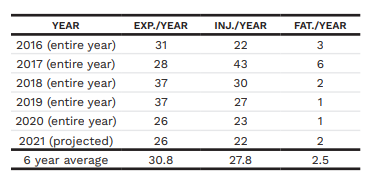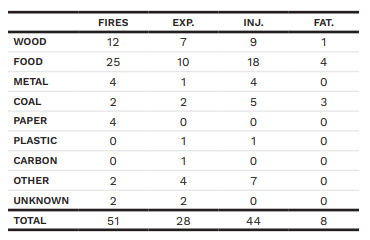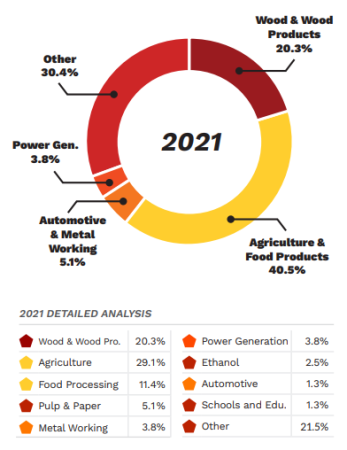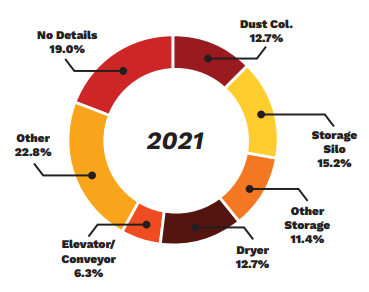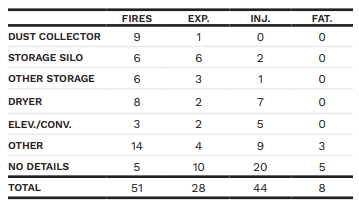
Dust Safety Science releases 2021 mid-year incident report
November 11, 2021
By Dust Safety Science
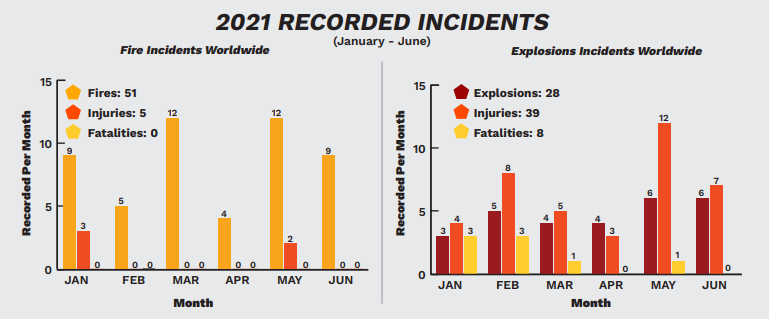
Dust Safety Science aggregates their incident research twice a year into Incident Reports, and this most recent report includes all incidents they’ve captured from Jan. 1, 2021, to June 30, 2021.
These are broken into fires and explosions occurring in North America and Internationally throughout the world.
We have been recording combustible dust incidents as part of DustSafetyScience.com since 2016.
The following table compares the number of incidents, injuries and fatalities entered into the database since we started recording.
Loss history – United States
Loss history from dust explosions in the United States over the last five years is given in the following table. This data has been collected in the incident database and reported in the combustible dust incident reports, 2016 to 2021.
This data gives an average of 31 dust explosions per year, 28 injuries and three fatalities over the last six years. Note that dust fires are excluded in this analysis.
2021 global loss overview
In 2021, 70 per cent of the fatalities recorded occurred due to dust explosions. In the first half of 2021, all of the fatalities recorded occurred due to dust explosions. Of the injuries, 89 per cent occurred due to explosions and 11 per cent occurred due to fires.
Some of the more severe incidents include:
- One killed in seed cleaning dust explosion (Silverton, Ore.)
- Three injured in grain elevator fire (Brooks, Alta.)
- Three killed in power plant explosion (Angren, Uzbekistan)
- Several killed in potato starch explosion (Tuas, Singapore)
Limited information has been available for damages from dust explosions and fires. From the information that is available, only two incidents resulted in more than $1,000,000 in losses so far:
- Fatal explosion causes $1.4M in damages (Sliverton, Ore.)
- Animal feed fire causes $2M in damages (North Java, N.Y.)
Materials involved
In reviewing the global incident data, food and wood products made up over 75 per cent of the combustible dust fires and explosions recorded.
These materials also resulted in 61 per cent of the injuries and 62 per cent of the fatalities. A breakdown of the fires, explosions, injuries and fatalities for each type of material is given as follows:
The four injuries from metal dust involved an explosion at a zinc powder facility. The three fatalities and three injuries from coal dust were involved in an explosion at a thermal power plant. The other two injuries from coal dust involved an explosion at a carbon production facility.
Under the category “other,” two injuries came from separate explosions involving rubber dust. Four workers were injured in an unspecified chemical dust explosion at a pharmaceutical plant. One worker was also injured in a sulfur dust explosion at a tire manufacturing plant.
Industries involved
As shown in the historical data, wood processing, wood products, agricultural activity and food production make up a large portion of the overall fire and explosion incidents. Since 2017, wood products have ranged from 21 to 28 per cent of the incidents, while agricultural activity and food production has ranged from 33 to 50 per cent.
As shown in the detailed incident breakdown, the “other” category includes pulp & paper, ethanol, high schools, and educational facilities. Industries not broken out in the detailed breakdown include rubber products, lawn products, graphite and carbon products, food packaging, pharmaceutical, residential, plastics and waste treatment.
Combined, the overall “other” category of industries makes up 45 per cent of the injuries and 37 per cent of the fatalities reported in the first half of 2021. Wood and wood products, agriculture and food processing, and automotive and metalworking make up 20 per cent, 25 per cent and 2.3 per cent of the injuries, respectively. Fatalities were recorded in wood and wood products, agricultural, power generation and fire protection system manufacturing industries.
Equipment and causes
In the first half of 2021, storage silos demonstrated the highest percentage of combustible dust incidents with six fires and six explosions reported. This is a higher percentage than the 2017 and 2018 reports which found that dust collection systems had the highest percentage of incidents. So far in 2021, only 13 per cent of the fires and explosions occurred in dust collection systems.
Dryers had the largest number of injuries in the first half of 2021 with four injuries in a pharmaceutical dryer explosion, one injury in a grain dryer explosion and one injury in a wood pulp and flower dryer explosion. Three storage silo and bin explosions resulted in three more injuries. The breakdown between fires, explosions, injuries and fatalities for different pieces of equipment are summarized in the following table for 2021:
Equipment labelled under “Other” had 23 per cent of the total incidents, 20 per cent of the injuries and 37 per cent of the fatalities. These incidents include an explosion involving a potato starch mixer that killed three and injured seven, and an explosion in a coal handling system that injured two.
Incidents for which no details were provided for the equipment made up 19 per cent of the total reported. However, these incidents made up 45 per cent of the reported injuries and 62 per cent of the reported fatalities.
For more information or to download a copy of the report, visit www.dustsafetyscience.com/2021-report.
Disclaimer
The contents of the incident reports are generated using publicly available news articles and resources. The data is provided for informational purposes only and is not meant as a replacement for professional guidance. Due to reliance on third-party news agencies, incomplete articles, and limited analysis methods, DustEx Research Ltd. makes no warranties or guarantees to the accuracy or completeness of the information provided.
Print this page

